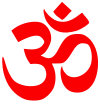
The Ramayana, also known as Valmiki Ramayana, as traditionally attributed to Valmiki, is a smriti text from ancient India, one of the two important epics of Hinduism known as the Itihasas, the other being the Mahabharata. The epic narrates the life of Rama, the seventh avatar of the Hindu deity Vishnu, who is a prince of Ayodhya in the kingdom of Kosala. The epic follows his fourteen-year exile to the forest urged by his father King Dasharatha, on the request of Rama's stepmother Kaikeyi; his travels across forests in the Indian subcontinent with his wife Sita and brother Lakshmana; the kidnapping of Sita by Ravana, the king of Lanka, that resulted in war; and Rama's eventual return to Ayodhya along with Sita to be crowned king amidst jubilation and celebration.

The Yoga Sutras of Patañjali is a collection of Sanskrit sutras (aphorisms) on the theory and practice of yoga – 195 sutras and 196 sutras. The Yoga Sutras were compiled in the early centuries CE, by the sage Patanjali in India who synthesized and organized knowledge about yoga from much older traditions.

Swami Tapasyananda (1904-1991) was a senior monk of the Ramakrishna Mission. He was born in the Palat family of Ottapalam in Kerala, in 1904. His pre-monastic name was K. P. Balakrishnan Menon. In 1921, when he was just 17 years old, he met Swami Brahmananda- a direct disciple and spiritual son of Sri Ramakrishna, in Chennai. He received Mantra-Diksha from Swami Shivananda in 1924, and joined the Order in 1926, at 22 years age after completing in post graduation. In 1932, he received Sannyasa from Swami Shivananda. He was a disciple of Swami Shivananda, one of the eminent disciples of Sri Ramakrishna. The Swami was a vice-president of the Ramakrishna Order from 1985-1991, giving Mantra-Diksha to a large number of devotees. He was an erudite scholar in Indian and Western philosophy. He has to his credit many books in English, including the translations of many scriptures. His translation of Bhagavata Purana in four volumes has been highly acclaimed in intellectual and devotional circles. He was the president of Ramakrishna Math, Chennai from 1971-1991. Swamiji was well known for his austere life and intuitive intellect. His deity was Lord Khrishna and he practiced spiritual activity as told by his Guruji. He was a prolific writer. Some of the books authored by him are listed below. He translated many Hindu classics into English from original Sanskrit. He founded Ramakrishna Mission Hospital at Thiruvananthapuram.

Trishanku, born Satyavrata, is a king of the Suryavamsha featured in Hindu texts. His legend is described in the epic Ramayana. He is the father of Harishchandra.

The Padma Purana is one of the eighteen Major Puranas, a genre of texts in Hinduism. It is an encyclopedic text, named after the lotus in which creator god Brahma appeared, and includes large sections dedicated to Vishnu, as well as significant sections on Shiva and Shakti.
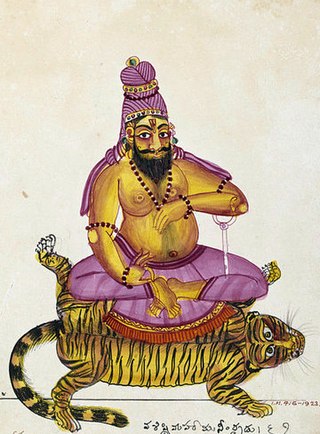
Vasishtha is one of the oldest and revered Vedic rishis or sages, and one of the Saptarishis. Vasishtha is credited as the chief author of Mandala 7 of the Rigveda. Vasishtha and his family are mentioned in Rigvedic verse 10.167.4, other Rigvedic mandalas and in many Vedic texts. His ideas have been influential and he was called the first sage of the Vedanta school of Hindu philosophy by Adi Shankara.
The Aparokshanubhuti is a work attributed to Adi Shankara, though his authorship is doubtful. It is a popular introductory work that expounds Advaita Vedanta philosophy.
The Guru Gita is a Hindu scripture that is said to have been authored by the sage Vyasa. The verses of this scripture may also be chanted. The text is part of the larger Skanda Purana. There are several versions of the Guru Gita, varying from around 100 to over 400 verses. Another view is that Guru Gita is part of Viswasara Tantra.
The Yoga Yajnavalkya is a classical Hindu yoga text in the Sanskrit language. The text is written in the form of a male-female dialogue between the sage Yajnavalkya and Gargi. The text consists of 12 chapters and contains 504 verses.
Venkatesananda Saraswati, known previously as Parthasarathy, was a disciple of Sivananda Saraswati. He received his spiritual training at the Divine Life Society in Rishikesh, India, and disseminated his master's teachings in South Africa, Mauritius, Australia, and New Zealand.
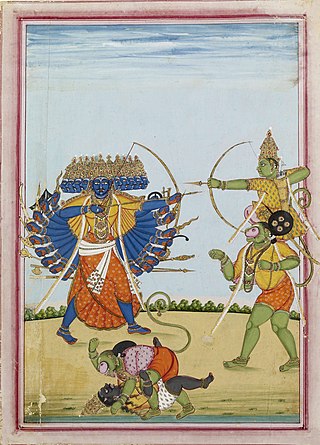
Depending on the methods of counting, as many as three hundred versions of the Indian Hindu epic poem, the Ramayana, are known to exist. The oldest version is generally recognized to be the Sanskrit version attributed to the sage Narada, the Mula Ramayana. Narada passed on the knowledge to Valmiki, who authored Valmiki Ramayana, the present oldest available version of Ramayana.
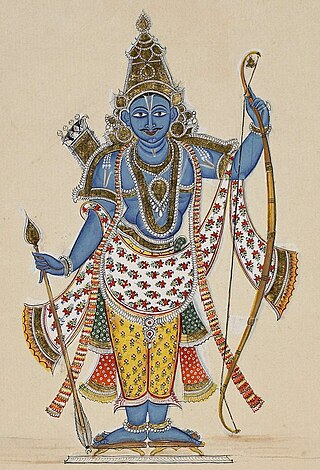
Rama is a major deity in Hinduism. He is worshipped as the seventh and one of the most popular avatars of Vishnu. In Rama-centric Hindu traditions, he is considered the Supreme Being. Also considered as the ideal man, Rama is the male protagonist of the Hindu epic Ramayana. His birth is celebrated every year on Rama Navami, which falls on the ninth day of the bright half of the lunar cycle of Chaitra (March–April), the first month in the Hindu calendar.

The Mokṣopāya or Mokṣopāyaśāstra is a Sanskrit philosophical text on salvation for non-ascetics, written on the Pradyumna hill in Śrīnagar in the 10th century. It has the form of a public sermon and claims human authorship and contains about 30,000 śloka's. The main part of the text forms a dialogue between Vasiṣṭha and Rāma, interchanged with numerous short stories and anecdotes to illustrate the content. This text was later expanded and vedanticized, which resulted in the Yogavāsiṣṭha.
The below list gives an overview of the contents and stories in the Yoga Vasistha, as it appears in Swami Venkatesananda's translation. The same stories are included in the Moksopaya, on which the Yoga Vasistha was based, as well.
Hindu scriptures are traditionally classified into two parts: śruti, meaning "what has been heard" and Smriti, meaning "what has been retained or remembered". The Vedas are classified under śruti.
Yoga philosophy is one of the six major important schools of Hindu philosophy, though it is only at the end of the first millennium CE that Yoga is mentioned as a separate school of thought in Indian texts, distinct from Samkhya. Ancient, medieval and most modern literature often refers to Yoga-philosophy simply as Yoga. A systematic collection of ideas of Yoga is found in the Yoga Sutras of Patanjali, a key text of Yoga which has influenced all other schools of Indian philosophy.

Vavilikolanu Subba Rao or Andhra Valmiki or Vaasu Daasa Swami was a Sanskrit scholar and a Telugu poet, often known by the epithet Andhra Valmiki.
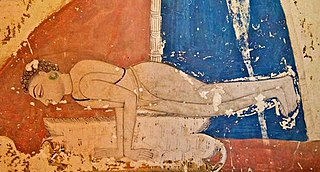
The Vasishtha Samhita is a 13th-century medieval Vaishnavite text, one of the first to describe non-seated hatha yoga asanas including the arm-balancing Kukkutasana, Cockerel Pose. It makes use of the 10th-century Vimanarcanakalpa, whose verse it paraphrases in prose to describe what may be the first non-seated asana, the arm-balancing Mayurasana, Peacock Pose. These descriptions in turn were exploited by the 15th century Hatha Yoga Pradipika.

Drsti-srsti is a subschool of Advaita Vedanta, possibly started by Maṇḍana Miśra. It holds that the "whole world of things is the object of mind," and influenced the Yoga Vasistha.

